The wiki is lacking in content. You can help by creating a new article. See the to do list for more ways you can help.
Account creation has been restricted to people who have accounts. Please stop by the Discord Server to request an account.
Final Fantasy VII
| Final Fantasy VII | |
|---|---|
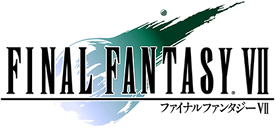
| |
|
ファイナルファンタジー | |
| Developer(s): | |
| Publisher(s): | |
| Platform(s): |
PlayStation, Windows, iOS/Android, PlayStation 4, Xbox One, Nintendo Switch |
| Release date: |
PlayStation: |
| Genre: |
Role-playing game |
| Modes: |
Single player |
| Ratings: |
ESRB: Teen |
| On partnered websites | |
| Switcher.gg: | Find Final Fantasy VII friends online |
Final Fantasy VII is the seventh installment of the main Final Fantasy series, and it was originally released for the PlayStation in 1997. The game has its own subseries, the Compilation of Final Fantasy VII and a remake for the PlayStation 4, titled Final Fantasy VII Remake. In 2005, the game received an unlicensed Famicom port exclusive to China.
Final Fantasy VII is widely as one of the most influential and greatest video games of all time, as well as the Final Fantasy series. It is credited with providing mass-market appeal to console RPGs outside of Japan.[2] Final Fantasy VII was the first game of the series that used 3D character models on 2D pre-rendered backgrounds and full-motion video sequences. It is the first Final Fantasy game that was released for a Sony console, and several Final Fantasy games would be released as console exclusives for the PlayStation line of systems.
The game's main setting is a planet largely industrialized by the Shinra Electric Power Company, a mega-corporation that profits from mining the planet's natural resources for energy. The main protagonist and playable character is Cloud Strife, a mercenary who works with the eco-terrorist group AVALANCHE in their fight against Shinra. Along the way, Cloud gathers a party of people whose lives have been variably affected by Shinra's exploits. The main antagonist is Cloud's nemesis, Sephiroth, who tries to become a demigod after learning about his origin.
Story[edit]
Disc 1[edit]
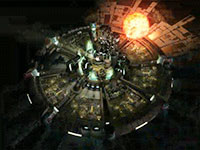
The story begins with Cloud joining a group known as AVALANCHE in a series of raids against the Mako reactors that surround the city of Midgar. Although their first mission, which was to blow up the Mako Reactor 1, is a success, AVALANCHE is trapped at another reactor during a subsequent raid. Before they can escape the reactor explodes, launching Cloud from the upper levels of Midgar into the slums below. He lands unharmed on a flower bed, where he is formally introduced to Aeris. Prompted by the arrival of Shinra's Turks operatives sent to capture Aeris, Cloud agrees to work for Aeris as her bodyguard.
After Cloud defends Aeris from her would-be kidnappers, Aeris offers to show him the way back to Sector 7. They then meet up with Tifa Lockhart, and the three infiltrate Corneo Hall, the mansion of crime boss Don Corneo. From him, the party learns that Shinra has discovered the location of AVALANCHE's hideout and plans to collapse the upper level of Sector 7 onto the slums below. Despite AVALANCHE's efforts to prevent it, Shinra successfully destroys Sector 7, killing its population and three members of AVALANCHE. The Turks finally capture Aeris, who is the last living member of the Cetra, a race closely attuned with the planet, and previously thought extinct. President Shinra believes that Aeris can lead him to a mythical land of fertility known as the Promised Land, which he expects to be ripe with easily harvested Mako energy.
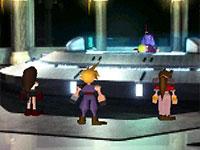
The remaining members of AVALANCHE—Cloud, Tifa, and Barret—infiltrate Shinra's headquarters to rescue Aeris. After freeing her and Red XIII, who joins the party, they escape when most of the personnel in the building are killed, including President Shinra. Finding the body of the president skewered by a masamune, Cloud suspects a man called Sephiroth has returned from his presumed death. These suspicions are confirmed by an executive spared during the massacre, who claims to have witnessed Sephiroth murder the president and state that he would never allow Shinra to claim the Promised Land. The party also learns that during Sephiroth's attack on Shinra, the headless body of a creature named Jenova disappeared from the building's research facility.
While Rufus Shinra, the president's son, assumes control of the Shinra Company, AVALANCHE pursues Sephiroth across the planet, fearing his intentions for the Promised Land may be more destructive than Shinra's. During this pursuit, the party is joined by Yuffie Kisaragi, Cait Sith, Vincent Valentine, and Cid Highwind. As the journey progresses, each member of the group must come to terms with personal conflicts from their past, and the full scope of Sephiroth's plan is eventually revealed: if the planet is significantly damaged, the Lifestream within will gather at the point of injury, attempting to heal the wound. Sephiroth explains that he intends to use a powerful spell known as Meteor to summon a powerful meteor that would heavily damage the planet, inciting a reaction in the Lifestream to heal the wound before it can cause the planet's destruction. Entering the fissure created by the meteor's impact, Sephiroth would merge with all the energy of the planet, granting him god-like power over it. At the Temple of the Ancients, AVALANCHE attempts to undermine Sephiroth's plot by claiming the Black Materia needed to activate Meteor, but Sephiroth displays a mysterious power over Cloud, forcing him to relinquish the Black Materia.
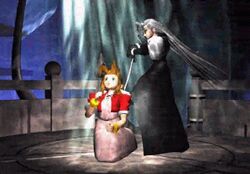
At an inn in Kalm, Cloud tells the party his story five years ago. During a Shinra mission at Nibelheim, the hometown of Cloud and Tifa, Sephiroth learned that he was the product of this experiment. However, unaware of all details involved, he concluded that he was a Cetra who had been produced solely from Jenova's genetic material. Enraged, Sephiroth burned down the town, intending to kill all descendants of those he believed had abandoned his ancestors in the defense of the planet. According to Cloud, he confronted Sephiroth during this massacre, after which Sephiroth vanished under unknown circumstances and was presumed dead until his reappearance in the Shinra Building.
Fearing that Sephiroth may cast Meteor, Aeris sets off to stop him on her own. Concerned for Aeris's safety, AVALANCHE follows her to the Northern Continent, where they enter the Forgotten City, an ancient city once populated by the Cetra. After finding Aeris praying to the planet for aid, Sephiroth, unseen, begins affecting Cloud's behavior, once again, and attempts to force him to kill her. Cloud resists Sephiroth's command, but Sephiroth himself appears and kills Aeris. After laying her body to rest, the surviving characters resolve to defeat Sephiroth and avenge her.
Disc 2[edit]
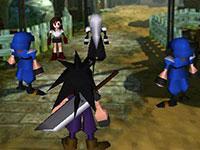
In the middle of the night, Cloud has a vision of Sephiroth heading north. He gathers the party together and arrive in Icicle Inn. In one of the houses, Cloud finds old videos belonging to Professor Gast. In the videos, Gast interviews Ifalna, one of the last Cetra. She teaches Gast of an interstellar creature that crash-landed on the Planet 2,000 years ago. It traveled via a meteor, whose collision formed a large impact crater, grievously harming the planet. The creature, who came to be known as Jenova, emerged from the crater, intending to infect all living organisms on the planet with a virus that would induce insanity and incite monstrous transformations. Among its victims were most of the Cetra, who were approached when Jenova used its mimic abilities to appear as their relatives. Attempting to defend itself, the planet created giant monsters called WEAPONs. Rather than deciding to fight Jenova, a majority of the humans fled. However, a small group of Cetra survivors fought to defend the planet and managed to defeat Jenova, confining it within the crater that was formed by its landing. Afterward, the WEAPONs entered hibernation to await any possible threat to the planet. Gast and Ifalna came to fall in love and would conceive a child named Aeris.
When AVALANCHE reaches the Northern Crater, Sephiroth tells Cloud that he was not in Nibelheim, and shows him images of a 1st Class SOLDIER with dark hair who occupies Cloud's place in his memories. With Tifa unable to refute Sephiroth's claims, Cloud goes crazy and, thinking it the right thing to do, gives the Black Materia to Sephiroth's real body, which is encased in crystalized Mako. (Earlier, Cloud was pursuing a clone of Sephiroth, who led him to his real body.) This results in the reawakening of the WEAPONs. In the earthquake that follows, Cloud is separated from his companions and falls into the Lifestream.
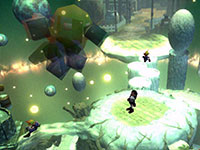
As the meteor summoned by Sephiroth slowly approaches the planet, Shinra focuses its efforts on protecting humanity from the WEAPONs, who have begun to perceive everything as a threat to the planet. The members of AVALANCHE are interrogated, and eventually nearly executed. They escape from Junon and obtain Cid's airship, the Highwind, allowing them to travel anywhere on the overworld. They then search for Cloud. They discover Shinra's plan to take Huge Materia from the major spots of the world. Barret Wallace saves his hometown from Shinra's escort, thus redeeming himself for building the Mako reactor there in the first place. They eventually find Cloud, locating him on a tropical resort island called Mideel, where he washed up following the casting of Meteor; he is in a catatonic state. Unable to see Cloud like this, Tifa resolves that she refuses to leave until Cloud has fully recovered. The WEAPONs' destructive activity quickly causes the island to split open, depositing Cloud and Tifa into the Lifestream below. There, she reconstructs Cloud's memories in his subconscious and learns the truth about his past. While Cloud had actually been in Nibelheim during Sephiroth's attack, he never successfully joined SOLDIER and only managed to attain the rank of private in Shinra's military. It is revealed that the dark-haired SOLDIER is named Zack. During Sephiroth's destruction of Nibelheim, Zack, Tifa and Cloud fought Sephiroth in Nibelheim's Mako reactor. Although Tifa and Zack were defeated, Cloud and Sephiroth severely wounded one another. After decapitating the body of Jenova, which had been stored in the Mako reactor, Sephiroth is thrown into the Lifestream by Cloud, taking the creature's head with him. Rather than dying, his body and consciousness were crystalized in Mako inside Jenova's crater.
Disc 3[edit]
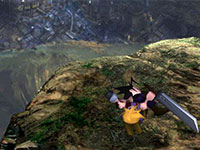
In an optional flashback at Nibelheim, it is shown that Cloud and Zack were among the wounded survivors who were apprehended by Shinra as part an elaborate cover-up of Sephiroth's massacre. Professor Hojo subjected these survivors to an experiment, in which he performed the same enhancements given to members of SOLDIER. However, because Hojo conducted the experiment without any concern for the subjects' mental capacities to handle the procedure, all but Zack entered a comatose state. Nearly five years later, Zack broke free from his confinement and took Cloud with him. It is revealed that the procedure used to enhance members of SOLDIER involved both Mako showers and the injection of cells from Jenova. The alien cells inhabiting Cloud's body allowed his mind to construct a false persona, built around Zack's behavior, fighting style, and description of Sephiroth's destruction in Nibelheim, but they also allowed Sephiroth to modulate his behavior. The cells' inherent ability to duplicate information led Cloud to believe he had been the 1st Class SOLDIER in Nibelheim, as Zack was killed outside Midgar by Shinra soldiers after saving Cloud's life. During Zack's final moments, he tells Cloud to live "both of their lives" before taking his final breath. Afterward, Tifa discovered Cloud, who was wearing a SOLDIER 1st Class uniform, which Zack gave him at the Shinra Mansion when they escaped from Hojo's experiment, and offered him a job with AVALANCHE.
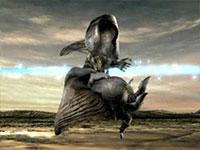
Back in the present, Cloud awakens and, having learned the truth, rejoins AVALANCHE. Before Cloud awakened, the few members of AVALANCHE recovered Huge Materia to counter Shinra's attempts to destroy the WEAPONs and Meteor. During the next few segments, many members achieve their lifelong dreams, or settle their past. Cid became the first man in outer space, Yuffie encourages her father to return her hometown Wutai to its former glory, and Vincent Valentine learns the truth about his past.
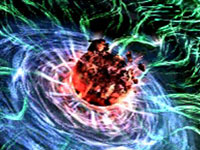
With the help of Bugenhagen, the elder of Cosmo Canyon and grandfather of Red XIII, the party discovers that Aeris, just before dying, was casting a spell named Holy as a means to oppose Meteor. Though she succeeds, Sephiroth's focused will prevents the spell from taking effect, and has been restraining it since. Deciding that humanity must be protected from the WEAPONs before Sephiroth can be approached, Shinra and AVALANCHE destroy the WEAPONs, but nearly all of Shinra's executives are killed in the process, seemingly including Rufus. Among the few survivors are Reeve Tuesti, revealed to be the repentant controller of Cait Sith, and Professor Hojo, who is revealed to be Sephiroth's biological father. He explains that he and his wife were assistants to Professor Gast, and offered up their unborn child as a test subject to research involving Jenova. When Hojo attempts to help Sephiroth gain mastery over the Lifestream afterward, AVALANCHE is given no choice but to fight and kill him. Cloud tells the remaining members of his team to go find what they are fighting for. Every member returns, including Cait Sith, who had been captured by Shinra for helping Cloud.
Just before dying from old age, Bugenhagen tells Red XIII to join Cloud for the final battle against Sephiroth. With each member of Cloud's group at peace with his or her past and all other opponents defeated, the group travels through the mantle of the planet to its core, where they defeat Sephiroth and free Holy. However, due to Meteor's already close proximity to the planet's surface, Holy is unable to destroy it alone. Selected as Meteor's target, Midgar is almost completely destroyed by the storms that spawn from its presence. However, sent by Aeris' spirit, the Lifestream itself rises from the planet to aid Holy by pushing Meteor away, allowing Holy to destroy it. Five hundred years later, Red XIII is seen with two cubs looking out over the ruins of Midgar, which are now covered in greenery, showing that the planet has healed.
Gameplay[edit]

The core gameplay is similar to the first six Final Fantasy games, although some new mechanics are introduced, especially since Final Fantasy VII is the first 3D game of the series. Several areas have a 2D pre-rendered graphic as a background to create the illusion of a 3D environment, but can still be explored as if it were one. The world map and battle scenes are entirely rendered in 3D. Unlike the earlier Final Fantasy installments, which usually allow up to four party members, the player can only have up to three party members at a time.
At first, the party is restricted to Midgar, but once the world map becomes accessible, their adventure becomes less linear. As is the case with earlier Final Fantasy titles, the world map features random encounters with enemies. Progression through the game occurs with scripted sequences or, to a lesser extent, pre-rendered cinematic cutscenes.
On the world map, there are some natural barriers, such as mountains, deserts, and bodies of water, which prevent the characters from reaching certain areas by foot. As their journey progresses, the party receives vehicles that can overcome certain obstacles on the world map and reach these areas. Late into their journey, the party receives Cid's airship, the Highwind, which can access any place on the world map.
It is possible for the party to temporarily recruit a Chocobo to ride around on the world map. In order to do this, a party member must have the Chocobo Lure materia equipped and go to Chocobo tracks, where there is a chance of a Chocobo appearing during a random enemy encounter. While fighting the enemies, the party can feed a greens to the Chocobo to keep it distracted so that it does not flee. Once the battle has ended, they can ride the Chocobo around on the world map until they dismount it, after which the Chocobo flees back into the wild. While riding a Chocobo, the party can avoid encountering enemies and travel across light bodies of water. Later on, it is possible for the party to raise their own Chocobos at the Chocobo Farm and breed different variants, including green, blue, black and gold, each capable of getting across certain terrains.
Combat[edit]
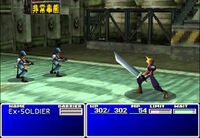
The game reuses the Active Time Battle system, which first appeared in Final Fantasy IV. The game introduces Limit Breaks, a modified form of Final Fantasy VI's Desperation Attacks. Each character has their own Limit Breaks, which are powerful attacks that are usually capable of dealing more damage than regular attack. Every character has their own Limit Break bar that gradually fills as they take damage during a battle. The character can only use their attack once the bar has been filled.
The game introduces a skill system that is built around the use of magical orbs known as materia. From the Menu Screen's Materia sub-menu, the materia can be applied to empty, circular slots to enhance either the weapon, armor, or accessory of a character; their magic spells, summons, and special abilities are changed accordingly. On the other hand, characters with more materia equipped become physically weaker. It is possible to join materia together to create different effects.
Characters[edit]
- Main article: List of characters in Final Fantasy VII
Playable characters[edit]
There are nine playable characters, two of which are optional characters. All of them are members resistance group, AVALANCHE. Sorted from earliest to latest in-game appearance:
- Cloud Strife - The main protagonist of the game, Cloud is a mercenary employed by AVALANCHE. He was formerly a member of Shin-Ra's SOLDIER division.
- Tifa Lockhart - A young woman skilled in martial arts, Tifa is a childhood friend of Cloud. Early in the game, she was the person who convinced Cloud to join AVALANCHE.
- Barret Wallace - The brash leader of AVALANCHE and father of Marlene. Barret has a robotic arm that he uses during battle.
- Aerith Gainsborough - A friendly young woman who sells flowers. Aerith is one of the few survivors of the Cetra race, and is sought after by Shin-Ra, who want to exploit her magical powers to reach the fabled Promised Land.
- Red XIII - A strong lion-like animal who joins AVALANCHE after being rescued from a Shin-Ra experiment.
- Cait Sith
- Cid Highwind
- Yuffie Kisaragi (optional)
- Vincent Valentine (optional)
Note that during Cloud's flashbacks, Sephiroth (who is at level 50) fights alongside Cloud in some battles, although the player cannot control or equip Sephiroth.
Antagonists[edit]
Several of the game's antagonists are employees of Shin-Ra:
- Heidegger - He is in charge of Shin-Ra's "Peace Preservation Department".
- Hojo - A scientist who is in charge of Shin-Ra's "Science Department".
- President Shinra - He was the head of the entire Shin-Ra before Sephiroth killed him.
- Reeve - He is in charge of the "Head of Urban Development" division.
- Rufus - The son of President Shinra. He was formerly Shin-Ra's vice president until his father died, so Rufus inherited the company.
- Scarlet - He is in charge of Shin-Ra's "Head of Weapons Research and Development" division.
- Sephiroth - The overall main antagonist, Sephiroth was a high-ranked member of SOLDIER. At one point, he worked alongside Cloud. Sephiroth became evil after learning that he was artificially created as a result of the Jenova Project.
- Turks - an investigative group of assassins that work on behalf of Shin-Ra. It consists of four members: Elena, Rude, Reno, and its leader Tseng.
Bosses[edit]
|
|
Locations[edit]
The whole game takes place within a world named The Planet. Like Final Fantasy VI, the technology is more advanced than earlier installments of the franchise. The Planet is made up of three continents, accessed in order from east, west, then north.
Eastern continent[edit]
- Midgar – An industrial metropolis where both Shin-Ra and AVALANCHE are based, and it is the starting area.
- Sector 7 Slums – A village beneath the upper Sector 7 plate.
- Wall Market – A black market area where Corneo Hall and the Honey Bee Inn are located.
- Shin-Ra Headquarters – A 70-story building that serves as the headquarters for Shin-Ra and their divisions.
- Kalm – A small medieval Europe-inspired town near Midgar.
- Chocobo Farm – A farm used as a breeding area for Chocobos. It is where the group can purchase the Chocobo Lure materia and some greens, both of which are needed to catch a Chocobo.
- Mythril Mine – An abandoned mine and a former mining area for the inhabitants of Kalm.
- Fort Condor – A military fortress dedicated to resistance against Shin-Ra. It is named for the massive breed of Condor that lives there.
- Junon – A heavily-armed Shin-Ra military base that is located above a small fishing town of the same name. It is built upon a plate and houses troop garrisons, an airport, and a seaport.
- Underwater Reactor – The primary Mako reactor for the city of Junon.
Western continent[edit]
- Costa del Sol – A port town that also serves as a seaside resort.
- Corel – The hometown of Barret, later destroyed from an attack on its Mako Reactor. Ever since, Corel was turned into a prison site.
- North Corel – A town that the people of Corel have inhabited ever since the original town was destroyed.
- Gold Saucer – An amusement park owned by Shin-Ra that is located in the desert.
- Gongaga – The remains of a town that was destroyed by a reactor explosion. It is where Zack lived.
- Cosmo Canyon – The hometown of Red XIII, Cosmo Canyon is a site for studying natural life. An observatory owned by Bugenhagen is located here.
- Ancient Forest – A very old forest near Cosmo Canyon. Only accessible by a Green, Black, or Gold Chocobo, or after destroying the Ultimate WEAPON completely.
- Nibelheim – The hometown of Cloud and Tifa.
- Rocket Town – Cid's hometown and the site of Shin-Ra's former space program, where the first rocket launch took place.
- Wutai – It is Yuffie's hometown and formerly an independent nation before Shin-Ra took over and converted it into a tourist resort.
Northern continent[edit]
- Bone Village – A excavation site where the Lunar Harp is located.
- Sleeping Forest – Next to Bone Village, it is an enchanted forest that the party can only pass through with Lunar Harp.
- Forgotten City – A lost city of the Ancients and the location where Aerith tried using the White Materia to summon Holy.
- Icicle Inn – The hometown of Aerith, Icicle Inn is town set in an area where it snows year-round. It hosts a snowboarding minigame, Snow Game.
- Great Glacier – A large glacier to the south of Gaea's Cliffs.
- Gaea's Cliff – A large cliff that leads to the Whirlwind Maze.
- Whirlwind Maze – An area at the bottom of North Crater. A lot of Mako energy is located here.
- Mideel – A tropical town which is situated on an island. It was attacked by Ultimate WEAPON and destroyed by a Lifestream eruption.
- Northern Cave – This is the final area and is where the climax takes place.
Other[edit]
- Materia Caves – Caves scattered around the world map where very rare and variable materia can be found. They can only be reached with the help of a Chocobo.
- Temple of the Ancients – A large structure that the Black Materia was turned into to prevent it from being used. The building can only be reverted back to Black Materia if someone solves a series of puzzles to shrink the temple, although this causes the person to die.
Development[edit]
Super Famicom era[edit]
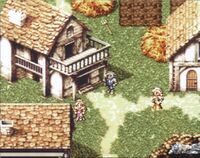
Initial discussion of Final Fantasy VII began sometime in 1994 for the Super Famicom, after Final Fantasy VI finshed development. At the time, home consoles were shifting over to 3D graphics, so a few ideas were proposed over which direction Final Fantasy VII would take. Series creator Hironobu Sakaguchi took the role of producer and Yoshinori Kitase as director. Sakaguchi was very fond of pixel art, and he and Kitase had a long debate on whether they should retain the pixel art style of the first six Final Fantasy series titles.[3] Kitase was concerned that the Final Fantasy series would fall behind if they did not utilize 3D graphics.[4]
According to Tetsuya Nomura, the first plot treatment, done by Sakaguchi, had the game set in New York, where a character named Detective Joe was investigating characters who tried destroying the Mako Reactors. In the same interview, Sakaguchi was unsure of the validity of the original plot, having recalled the New York idea to be for Parasite Eve.[3]
The same year, Chrono Trigger needed more staff to aid in its development, so Final Fantasy VII's entire team, consisting of about 20-30 members, joined alongside them to finish the game before returning to develop Final Fantasy VII. Some time before or after the event, a 2D prototype of Final Fantasy VII was created. It had an isometric view, unlike the six earlier Final Fantasy installments, and Locke Cole, one of the protagonists from Final Fantasy VI, was used as a placeholder character.[3]
Transition to 3D[edit]
Final Fantasy VII was the first 3D game to be developed by Square. When Square transitioned to 3D, they decided to first use it for a tech demo titled Final Fantasy VI: The Interactive CG Game, which was created using Silicon Graphics workstations and features some Final Fantasy VI characters in a 3D battle scene. In August 1995, it was presented at the SIGGRAPH 1995 exhibition so that the public could get an idea of how Final Fantasy games could look in 3D.[3] Although the tech demo featured Final Fantasy VI characters, it became the basis of Final Fantasy VII.[5]
At the time, the two main home consoles were the PlayStation and the Nintendo 64, and Square was faced with a decision on which console they would produce the game for. Because Nintendo 64 games also used Silicon Graphics imagery, many people, including media outlets, were led to assume that Final Fantasy VI: The Interactive CG Game meant that the next Final Fantasy installment would be for the Nintendo 64, especially because Square almost exclusively released their games on Nintendo consoles at the time. There was a brief period when Square experimented with the Nintendo 64, specifically the Nintendo 64DD peripheral, to get an idea of how Final Fantasy VII would play on it. A 2,000 polygon Behemoth was added as a test model, and the limited specifications of the Nintendo 64 caused a very slow response in framerate.[3] A lot of motion data and visual effects were also added, and because of the game's size, Square had to choose the CD-ROM, a type of media which the PlayStation uses, to contain all of the data.[5] Some time in early 1996, Square announced that they had shifted Final Fantasy VII and the rest of their lineup to the PlayStation.[3]
Sony PlayStation era[edit]
At first, sometime before announcing their move to PlayStation, Square was approached by Sony, who offered them to make games for their PlayStation. At first, Square was hesitant in partnering with Sony because they had a close relationship with Nintendo. Some time during the Nintendo 64's development, Square had several suggestions, such as adding a CD-ROM drive, and noted that the Nintendo 64 was not powerful enough to handle RPG titles, namely Final Fantasy VII. Square's concerns were not met, so Sagakuchi and the rest of Square ceased development for the Nintendo 64 and moved over to Sony, ending their relationship with Nintendo for a long time.[3]
With development having moved to the PlayStation, Square purchased hundreds of Silicon Graphics workstations and greatly expanded their team to about 150 members, which was very large for a game's development team at the time. The team purchased Silicon Graphics Onyx supercomputers and related workstations, and accompanying software including Softimage 3D, PowerAnimator, and N-World for an estimated total of $21 million.[3] The development team was split between both Square's Japanese offices and their American office in Los Angeles, with the latter team primarily working on city backgrounds.[6]
One of the major events in development was when the real-time graphics were synchronized to computer-generated full-motion video cutscenes for some story sequences, including an early sequence where a real-time model of Cloud jumps on a moving train rendered by FMV.[3] The backgrounds were created by overlaying two 2D graphic layers and changing the motion speed of each to simulate depth perception.[7] The biggest issue with the 3D graphics was the large memory storage gap between the development hardware and the PlayStation itself, which only has two megabytes of system memory and 500 kilobytes for texture memory. The team had to figure out how to shrink the amount of data while preserving the desired effects. This was aided with reluctant help from Sony, who had hoped to keep Square's direct involvement limited to a standard API package, but they eventually relented and allowed the team direct access to the hardware specifications.[3]
By early 1997, a year after moving to PlayStation and increasing their workforce, Square completed development of Final Fantasy VII.
Reception[edit]
Sales[edit]
- Main article: Final Fantasy Sales
Critical reception[edit]
Final Fantasy VII received universal critical acclaim upon release. Reviews from video game magazines and newspapers were highly positive, with 49 reviews giving an average aggregate score of 97%, including 26 perfect scores, according to Magazines from the Past.[8]
In North America, the game received 17 perfect scores from reviews in North American print publications upon release.[8] GameFan called it "quite possibly the greatest game ever made," a quote which featured prominently on the back cover of the game's jewel case.[49] The Electronic Gaming Monthly panel of four reviewers gave the game scores of 9.5 out of 10 each, adding up to 38 out of 40 overall.[20][50] GamePro praised the "massive world," experimentation "with spells and weapons, encounters with weird creatures," and "soap opera-ish story line", stating it has "classic" written "all over it."[24] Game Informer called it "the most amazing RPG we've ever seen"[51][52] and "the best RPG ever made."[23] Just Adventure called it "the greatest game ever created" and "a work of art" and "masterpiece that goes beyond video games." They praised the "very dark and emotional story" as "beautifully conceived" and called it "a very inspirational and powerful video game."[33]
In the United Kingdom, Edge noted, "The 'interactive movie' has long been a dirty term to anyone who values a playable videogame, but FFVII succeeds in coming closer than any title yet," with the "highly complex, melodramatic story and excellently orchestrated chip music" combining "to make players feel real empathy with the characters," a "task usually shied away from by the action/comedy-orientated western graphic adventures."[53] Paul Davies of Computer and Video Games described it as "truly unique" and "an incredible new era of interactive entertainment" that could "revolutionize" belief of "what a video game can achieve", with arguably "some of the best moments in entertainment history", including "excitement" and "heart-rendering" emotional scenes, concluding that, with a "thrilling" storyline "brought to life with ingenious" gameplay, the "future of PlayStation is assured by this key to the future of games."[14]
The game's visuals and use of FMV cutscenes were lauded by critics. IGN's Jay Boor insisted the game's graphics were "light years beyond anything ever seen on the PlayStation", and regarded its battle system as its strongest point.[31] Critics also praised its gameplay and writing. In Computer and Video Games magazine, Paul Davies said the "thrilling" and "magnificent plot" would "rock your emotions" and "revolutionise your belief of what a video game can achieve"[14] while Alex C praised the dramatic story and well-developed characters.[15] In addition to calling the graphics "bar none the best the PlayStation has ever seen", Next Generation said of the story that "while FFVII may take a bit to get going, as in every entry in the series, moments of high melodrama are blended with scenes of sheer poetry and vision".[36] Uematsu's soundtrack also attracted acclaim. Edge noted that Final Fantasy VII had come close to being an interactive movie in playable form, praising its combination of a complex story that went against Western graphic adventure trends and "excellently orchestrated chip music".[18] RPGamer praised the game's soundtrack, both in variety and sheer volume, stating that "Uematsu has done his work exceptionally well" and saying that it was potentially his best work.[54]
Digitiser praised the size of the game world, calling it the "largest video game" of all time, while considering the game "perfect in almost every respect".[17] Dan Toose of Hyper magazine praised the "sub-games" or minigames, particularly the motorbike minigame which reminded him of the anime film Akira (1988).[29]
Legacy[edit]
Impact[edit]
Final Fantasy VII is credited as having the largest impact of the Final Fantasy series.[55][56] In 2002, GameSpot ranked it as the second most influential game ever made.[57] In 2005, Electronic Gaming Monthly ranked it the 6th most important game since they began publication in 1989, stating it was "the first RPG to surpass, instead of copy, movielike storytelling" and taught gamers "how to cry".[58] In 2007, GamePro ranked it 14th on their list of the most important games of all time,[59] and in 2009 it was ranked the same place on their list of the most influential and innovative games of all time.[60] Bill Loguidice and Matt Barton listed Final Fantasy VII among the 25 most influential games of all time.[61] Samuel Roberts of Retro Gamer, writing for GamesRadar, called FFVII "one of the most important and influential RPGs of all time" in January 2020.[62] IGN said the game "revolutionised" role-playing games.[63] In 2018, The Strong National Museum of Play inducted Final Fantasy VII to its World Video Game Hall of Fame.[64]
The game is credited with allowing console role-playing games to gain mass-market appeal outside of Japan.[65] Role-playing video games were a niche genre in North America up until Final Fantasy VII introduced the genre to a mainstream audience there,[66][57][67] and it is the first main-line Final Fantasy game to have been released in Europe,[68] where its success generated mainstream interest in RPGs.[69] It popularized Japanese role-playing games outside of Japan, in addition to opening up the game console market for Western computer role-playing game developers such as BioWare.[61] According to Gene Park of The Washington Post, FFVII "single-handedly put role-playing video games on the global map".[70] It also boosted sales of the original PlayStation,[71] and demonstrated the advantages of CD-ROM media over ROM cartridge media.[59] According to Sony Computer Entertainment founder and PlayStation architect Ken Kutaragi, FFVII was "a driving force that propelled gaming forward" along with the PlayStation, and the game contributed to growing global awareness of Japanese popular culture along with anime.[70] According to Matt Alt, FFVII injected "a megadose of Japanese sensibilities" into the American mainstream, including "big-eyed bushy-haired anime" characters, manga-style melodrama, "androgynous heroes" and "the very idea that video games could be meditative explorations as well as thrill rides".[72]
FFVII was one of the first video games produced at a blockbuster (AAA) scale.[73] It was the most expensive video game ever developed up until then,[70] and its expensive advertisement campaign was also unprecedented for a video game.[74] It set a benchmark for video game graphics,[59][60] full motion video,[61] cinematic CGI production values, and movie-like presentation, along with its innovative blend of gameplay with dynamic cinematic camerawork.[70] It also set a benchmark for orchestral video game music,[70][60] with "Aerith's Theme" appearing on the Classic FM Hall of Fame at 16th place in 2012,[75] and with Elizabeth Davis of Classic FM calling it "one of the most famous pieces of video game music ever written" and stating that FFVII helped introduce "a whole generation to the magic of orchestral music".[76] The large number of minigames was also unprecedented for a role-playing game, inspiring numerous later titles to incorporate minigames.[63]
The game's storytelling was considered revelatory for its time and resonated with most of its audience.[77] The depth of its storytelling, along with its character building, emotional scenes, and cinematic production values, made it a landmark for video game storytelling.[57][59][60] Aerith's death in particular has often been referred to as one of the most significant moments from any video game.[78][79][80] It is one of the most iconic deaths in video game history,[74] is frequently cited as one of gaming's most shocking and emotional scenes,[81] and cemented Sephiroth's status as one of the most infamous video game villains.[81][59] The scene topped IGN's list of top 100 video game moments, calling it "a genre-defining moment" and representative of "gaming's emotional journey from kids' entertainment to modern storytelling medium".[80] Brian Taylor, writing for Kill Screen, described a cottage industry of fan theories for how to return Aerith to life or prevent her death. He compared these efforts to the letter-writing campaign to convince Charles Dickens not to let Nell, the endearing protagonist of The Old Curiosity Shop, die at the end of the book. Taylor affirmed that the acts of discussing these fan theories and dissecting the game code to test them comprise a valid and important part of the experience of the game.[82]
The game has inspired numerous developers. GameSpot stated that Final Fantasy VII was "the RPG that would influence every role-playing game that would follow" after it, and that its cinematic approach to storytelling was widely adopted by later RPGs.[57] Its Limit Break gameplay mechanic became a core mechanic in subsequent Final Fantasy games.[61] According to Samuel Roberts of Retro Gamer, the game's "character designs would shape Japanese RPGs for years to come".[62] Fable creator Peter Molyneux considers FFVII to be the RPG that "defined the genre" for him.[83][84] BioWare founder Greg Zeschuk cited FFVII as "the first really emotionally engaging game" he played and said it had "a big impact" on BioWare's work.[85] Black Isle Studios cited FFVII as an inspiration for Planescape: Torment (1999). According to Maciej Miszczyk of Hardcore Gaming 101, FFVII's spell animations and character quests may have influenced Western computer RPGs such as Planescape: Torment and BioWare's Baldur's Gate II (2000).[86] Media Molecule's Constantin Jupp credited FFVII with getting him into game design.[87] Tim Schafer cited FFVII as one of his favorite games of all time.[88] Thatgamecompany founder Jenova Chen cited FFVII as one of the biggest influences on his work and the game that inspired his adopted name (from the character Jenova).[89] Grinding Gear Games designer Chris Wilson cited the Materia system of FFVII as an influence on Path of Exile (2013).[90]
Themes[edit]
The game is noted for its cyberpunk themes, with GamesRadar+ calling it one of the best games of the genre,[91] and Harry Mackin of Paste Magazine comparing its cyberpunk city of Midgar to Akira and Blade Runner.[92] Aja Romano of The Daily Dot and Philip Boyes of Eurogamer cited Final Fantasy VII as an example of dieselpunk, a genre similar to steampunk.[93][94] According to Comic Book Resources, the game's environmental and climate change themes are more relevant and meaningful in 2019 than they were in 1997.[95] William Hughes of The A.V. Club notes that Barret and his terrorist cell AVALANCHE are one of the few examples of "heroic pop culture terrorists" in video games, and that the game's "political relevance remains" in a post-9/11 world.[96] Dani Di Placido of Forbes said the game was still relevant in 2020, drawing parallels between the game's events and contemporary issues such as climate change, environmental catastrophe, economic collapse, and the COVID-19 pandemic (comparing the latter to the game world after Meteor is summoned).[97] According to Stephen K. Hirst of Ars Technica, Final Fantasy VII inspired a generation of climate activists, including senior members of Greenpeace.[98] Murray Clark of Esquire argues that several characters wore clothing which anticipated several contemporary fashion trends.[99]
Final Fantasy VII is noted for its use of the unreliable narrator literary concept, drawing comparisons to later films such as Fight Club (1999), The Sixth Sense (1999), American Psycho (2000) and Memento (2000). Patrick Holleman and Jeremy Parish argue that the game takes the unreliable narrator concept a step further, with its interactivity establishing a connection between the player and the protagonist Cloud, setting FFVII apart from films as well as other video games.[100][101] According to Holleman, "no RPG has ever deliberately betrayed the connection between protagonist and player like FFVII does".[102] Ric Manning of The Courier-Journal noted elements of psychoanalysis in the game.[103] Sharon Packer identifies Cloud as having mental illness in the form of dissociative identity disorder (DID),[104] while Katie Whitlock identifies him as having involuntary memory resulting from post-traumatic stress disorder (PTSD).[105] Harry Mackin of Paste Magazine called the game "a subversion that deconstructs and comments meaningfully on how we think about heroism, masculinity and identity in videogame storytelling".[92] Jack Ridsdale of PCGamesN argues that Cloud is a deconstruction of the hero archetype and toxic masculinity, and compares the plot twist about his true identity to that of Fight Club.[106] According to Gene Park of The Washington Post, with its "cyberpunk story about personal delusions, mental illness, climate change and class warfare, it was Blade Runner for millennials".[70]
Pat Holleman's book Reverse Design: Final Fantasy VII (2018) examines the game's themes and topics in detail.[107] He summarizes the game's plot as telling "a story about survivors". He explains that it is "a story about characters who have outlived the people, places, and things that gave them their identities" and that most of the characters are "motivated by the loss of something that once defined who they are".[108] He notes that nearly all the major characters exhibit the "survivor's trio" which consists of losing "the world that defined" them, a "near-death experience" and "something that connects" them to their past.[107] He also notes that the game is, "at times, a deconstruction of a revenge story" in the sense that it "dismantles the idea of revenge in an insightful way". He considers Barret's story to be the clearest illustration of the "tragic survivorship" and "survivor's trio" themes, such as the loss of his coal mining hometown, seeking revenge through militant environmentalism before eventually realizing revenge isn't the right motivation, and safeguarding a future for his adoptive daughter Marlene who is the only surviving connection to his past. He also considers the Limit Break mechanic to be a gameplay representation of the survivorship theme. He argues that these are themes which only adults can fully relate to, and were misunderstood by much of the game's predominantly adolescent audience upon release.[108] Jessica Howard of GameSpot says that relationships, motherhood, politics and identity are central themes in Final Fantasy VII, and that it is "an extremely punk game, abundant with political sentiments and messages regarding the distribution of power, our treatment of the environment, and the evil found in complicity".[109]
References in other games[edit]
Note: This list does not include games within the Compilation of Final Fantasy VII.
- Final Fantasy Tactics: Cloud appears as an unlockable character.
- Xenogears: Tifa appears on a poster in Solaris.
- Ehrgeiz: God Bless the Ring: Cloud, Tifa, Sephiroth, Vincent, Yuffie and Zack appear as playable fighters.
- Chocobo Racing: Cloud appears as an unlockable playable racer.
- Kingdom Hearts series: Cloud, Aerith, Yuffie, Cid, and Sephiroth all make appearances in the first game. All of them, excluding Sephiroth, return in Kingdom Hearts: Chain of Memories. In Kingdom Hearts II, every character returns, and Tifa makes an appearance. The characters have made several other appearances in the Kingdom Hearts series.
- Dragon Quest & Final Fantasy in Itadaki Street Special: Cloud, Aerith, Tifa, and Sephiroth appear as playable characters. Both Midgar and the Gold Saucer appear as boards.
- Dragon Quest & Final Fantasy in Itadaki Street Portable: Cloud, Aerith, Tifa, and Sephiroth return as playable characters. Yuffie also makes an appearance as one.
- Super Smash Bros. for Nintendo 3DS / Wii U: Cloud makes an appearance as a DLC fighter, and has a corresponding home stage, Midgar, which itself features two of the battle themes as its music.
- Super Smash Bros. Ultimate: Cloud returns as a playable fighter, along with the Midgar stage, this time as part of the base game itself. Later, in December 2020, Sephiroth was introduced as a DLC fighter, and was given a home stage, Northern Cave. Several Final Fantasy VII-related spirits were introduced alongside Sephiroth. More Final Fantasy VII-related themes were added alongside the two from the Midgar stage.
References[edit]
- ^ "SCEE 1997 - Key facts and figures". SCEE Press Room (Wayback Machine).
- ^ 'Dirge of Cerberus' defies expectations, for better and worse. USA Today (archived).
- ^ a b c d e f g h i j "Final Fantasy 7: An oral history". Polygon.
- ^ Electronic Gaming Monthly issue 196, page 104.
- ^ a b "Press Clippings | Hironobu Sakaguchi Interview". The Final Fantasy VII Citadel (Wayback Machine).
- ^ "Exclusive Preview! Final Fantasy VII". Electronic Gaming Monthly issue 82 (May 1996), pages 78–79.
- ^ "Final Fantasy VII: An Interview With Squaresoft". Computer and Video Games issue 191 (October 1997), pages 53–59.
- ^ a b c https://magazinesfromthepast.fandom.com/wiki/Final_Fantasy_VII
- ^ http://www.mobygames.com/game/playstation/final-fantasy-vii/mobyrank
- ^ http://www.1up.com/reviews/final-fantasy-vii_2
- ^ https://web.archive.org/web/20141114121123/www.allgame.com/game.php?id=7852&tab=review
- ^ https://web.archive.org/web/20141114121120/www.allgame.com/game.php?id=9411
- ^ https://www.newspapers.com/newspage/168930954/
- ^ a b c Final Fantasy VII, Computer and Video Games, issue 192, November 1997, pages 52-5, EMAP
- ^ a b http://www.computerandvideogames.com/8069/reviews/final-fantasy-vii-review/
- ^ http://www.gamespot.com/rpg/finalf7/review_cgw.html
- ^ a b http://www.superpage58.com/digitiser-vault-teletext-screenshot-image-archive-1997-11-11.htm
- ^ a b https://web.archive.org/web/20120628000106/www.edge-online.com/reviews/final-fantasy-vii-review
- ^ http://www.lowbrowculture.com/edge/?querytype=publisher&query=Squaresoft
- ^ a b Electronic Gaming Monthly, issue 99 (October 1997) page 50
- ^ http://fs.finalfantasytr.com/search.asp?query=final+fantasy
- ^ GameFan, volume 5, issue 9 (September 1997), pages 67–70 (pages 26 & 67-70)
- ^ a b Game Informer, issue 53 (September 1997) pages 10–11 (pages 10-11)
- ^ a b GamePro, issue 109 (October 1997) pages 46–47 (Link)
- ^ http://www.gamepro.com/article/reviews/824/final-fantasy-vii/
- ^ Griffiths, Daniel, "Final Fantasy VII", GamesMaster, issue 63, Christmas 1997, pages=34–37
- ^ a b https://www.gamespot.com/reviews/final-fantasy-vii-review/1900-2536027/
- ^ https://retrocdn.net/images/e/e7/HobbyConsolas_ES_074.pdf#page=80
- ^ a b https://archive.org/details/hyper-049/page/50/mode/2up
- ^ https://archive.org/details/hyper-090/page/45
- ^ a b https://ign.com/articles/1997/09/04/final-fantasy-vii
- ^ http://pc.ign.com/articles/152/152301p1.html
- ^ a b http://www.justadventure.com/reviews/FF7/FF7_Review.shtm
- ^ a b https://www.ninretro.de/game-10-141.html
- ^ https://as.com/meristation/1997/11/15/analisis/879619920_011803.html
- ^ a b "Grand Finale", Next Generation, issue 34, Imagine Media, October 1997, page 170
- ^ https://archive.org/details/Official_US_PlayStation_Magazine_Volume_1_Issue_1_1997-10_Ziff_Davis_US/page/n85
- ^ Official U.S. PlayStation Magazine, issue 47 (August 2001), page 98
- ^ https://archive.org/details/Official_UK_Playstation_Magazine_1999_Future_Publishing_GB_platinum_special/page/n35/mode/2up
- ^ https://archive.org/stream/PC_Zone_Issue_066_1998-08_Dennis_Publishing_GB#page/n1/mode/2up
- ^ http://www.pcgamer.com/reviews/96.html
- ^ https://archive.org/details/PCPowerplay-027-1998-08/page/n77
- ^ https://archive.org/stream/PC_Zone_Issue_066_1998-08_Dennis_Publishing_GB#page/n91/mode/2up
- ^ http://www.ff7citadel.com/press/rev_aus.shtml
- ^ http://www.gamerankings.com/ps/197341-final-fantasy-vii/index.html
- ^ https://abandonware-magazines.org/affiche_mag.php?mag=32&num=1943&album=oui
- ^ PlayStation: The Official Magazine, issue 1 (September 1997), page 18 (Frost, Stephen, Imagine Media)
- ^ https://www.rpgfan.com/review/final-fantasy-vii-3/
- ^ GameFan Magazine, volume 5, issue 9, September 1997
- ^ Electronic Gaming Monthly, 1998 Video Game Buyer's Guide, page 72
- ^ Game Informer, issue 53, September 1997
- ^ Electronic Gaming Monthly, issue 100, November 1997 pages 1–3
- ^ http://www.edge-online.com/reviews/final-fantasy-vii-review/
- ^ https://web.archive.org/web/20160306190326/rpgamer.com/games/ff/ff7/reviews/ff7strev3.html
- ^ https://web.archive.org/web/20090611163946/www.gametrailers.com/video/part-v-final-fantasy/23449
- ^ https://web.archive.org/web/20081219083220/uk.gamespot.com/gamespot/features/all/greatestgames/index.html
- ^ a b c d https://web.archive.org/web/20070520043957/www.gamespot.com/gamespot/features/video/15influential_rc/p15_01.html
- ^ https://archive.org/details/electronic-gaming-monthly-issue-187-january-2005/page/48/mode/2up
- ^ a b c d e https://web.archive.org/web/20080913085022/http://www.gamepro.com/article/features/110068/the-52-most-important-video-games-of-all-time-page-4-of-8/
- ^ a b c d https://web.archive.org/web/20170314091900/www.pcworld.com/article/167229/20_games_that_changed_gaming_forever.html
- ^ a b c d https://books.google.com/books?id=mKF5AgAAQBAJ&pg=PA77
- ^ a b https://web.archive.org/web/20200521123616/www.gamesradar.com/final-fantasy-7-the-making-of-retrospective/
- ^ a b https://ghostarchive.org/varchive/youtube/20211114/fhvZLeFtgSw
- ^ https://www.museumofplay.org/games/final-fantasy-vii/
- ^ https://web.archive.org/web/20110629090116/www.usatoday.com/tech/gaming/2006-08-29-dirge-of-cerberus_x.htm
- ^ "Half a Million Clouds", Electronic Gaming Monthly, issue 101, Ziff Davis, December 1997, page 30
- ^ John Davison, "Change is Good", Electronic Gaming Monthly, issue 106, Ziff Davis, May 1998, page 6
- ^ https://books.google.com/books?id=OyuB3ECckp4C&pg=PA299
- ^ https://archive.org/details/Computer_and_Video_Games_Issue_195_1998-02_EMAP_Images_GB/page/n51/mode/2up
- ^ a b c d e f https://web.archive.org/web/20200408100434/www.washingtonpost.com/video-games/2020/04/03/final-fantasy-7-legacy-creators/
- ^ "The lack of a killer app", Computing Japan, 1997, volumes 36-41, page 44, LINC Japan: "Noguchi points out that every time sales of a particular game console have taken off, it has been because it had a new "killer software". Nintendo had Super Mario Brothers, Dragonquest, and Final Fantasy. And Sony PlayStation now has Final Fantasy VII, which has been selling like hotcakes since it was released at the end of January. Total shipments of PlayStation, which numbered 10 million worldwide as of November 1996, had jumped to 12 million by February 14 and 16 million by the end of May."
- ^ https://books.google.com/books?id=qYWhDwAAQBAJ&pg=PT9
- ^ https://web.archive.org/web/20200411165438/www.theguardian.com/games/2020/apr/11/final-fantasy-vii-remake-a-triumphant-return-for-cloud-strife
- ^ a b https://books.google.com/books?id=K599DwAAQBAJ&pg=PT148
- ^ https://web.archive.org/web/20120429171417/halloffame2012.classicfm.co.uk/individual/?position=16
- ^ https://web.archive.org/web/20200410171347/www.classicfm.com/composers/uematsu/aeriths-theme-final-fantasy/
- ^ https://web.archive.org/web/20200410155425/www.nytimes.com/2020/04/09/arts/final-fantasy-remake.html
- ^ ttps://web.archive.org/web/20141017180427/www.gamespot.com/articles/the-greatest-games-of-all-time-final-fantasy-vii/1100-6155700/
- ^ https://web.archive.org/web/20071015052721/www.gamespy.com/articles/798/798722p5.html
- ^ a b https://web.archive.org/web/20170118140008/www.ign.com/lists/video-game-moments/1
- ^ a b https://books.google.com/books?id=7cLcB_LdzegC&pg=PA264
- ^ https://web.archive.org/web/20140801034737/btphotographer.com/blog/2011/09/04/save-aeris-how-can-we-be-moved-by-the-fate-of-aeris-gainsborough-kill-screen/
- ^ https://web.archive.org/web/20190117070148/www.videogamer.com/news/molyneux_ffvii_that_to_me_defined_the_genre.html
- ^ https://web.archive.org/web/20181130030302/gematsu.com/2008/09/molyneux-final-fantasy-vii-defined-the-rpg-genre
- ^ https://youtu.be/uVihDspGt6k?t=3253
- ^ https://web.archive.org/web/20171122201835/www.hardcoregaming101.net/planescape-torment/
- ^ https://youtu.be/uVihDspGt6k?t=1847
- ^ https://youtu.be/uVihDspGt6k?t=1974
- ^ https://web.archive.org/web/20090102012220/www.joystiq.com/2006/09/18/joystiq-qanda-jenova-chen/
- ^ https://hardcoregamer.com/features/interviews/grinding-gears-about-path-of-exile-with-chris-wilson/35504/
- ^ https://web.archive.org/web/20190413091430/www.gamesradar.com/best-cyberpunk-games/
- ^ a b https://web.archive.org/web/20170202165741/www.pastemagazine.com/articles/2016/04/final-fantasy-viis-legacy-gets-everything-about-fi.html
- ^ https://web.archive.org/web/20191205015726/www.dailydot.com/parsec/fandom/dieselpunk-steampunk-beginners-guide/
- ^ https://web.archive.org/web/20200509234743/www.eurogamer.net/articles/2020-02-08-hot-air-and-high-winds-a-love-letter-to-the-fantasy-airship
- ^ https://web.archive.org/web/20200102202138/www.cbr.com/final-fantasy-viis-story-relevant-today/
- ^ https://web.archive.org/web/20200303184318/games.avclub.com/the-final-fantasy-vii-remake-has-heroic-terrorists-fak-1842012871
- ^ https://web.archive.org/web/20200501175830/www.forbes.com/sites/danidiplacido/2020/04/05/in-our-sci-fi-dystopia-of-2020-final-fantasy-vii-feels-more-timely-than-ever/
- ^ https://arstechnica.com/gaming/2021/07/how-final-fantasy-vii-radicalized-a-generation-of-climate-warriors/
- ^ https://www.esquire.com/uk/style/a32168572/final-fantasy-vii-7-remake-fashion/
- ^ https://books.google.com/books?id=GQprDwAAQBAJ&pg=PT36
- ^ https://web.archive.org/web/20190327191634/www.usgamer.net/articles/dissecting-final-fantasy-vii-part-5an-rpg-gets-existential-with-its-central-question-who-am-i
- ^ https://books.google.com/books?id=GQprDwAAQBAJ&pg=PT38
- ^ https://www.newspapers.com/newspage/110548492/
- ^ https://books.google.com/books?id=IKDPDgAAQBAJ&pg=PA231
- ^ https://books.google.com/books?id=ySTNDwAAQBAJ&pg=PT160
- ^ https://web.archive.org/web/20200409091848/www.pcgamesn.com/final-fantasy-7-remake/ff7-male-vulnerability
- ^ a b Holleman, Patrick, Reverse Design: Final Fantasy VII, 2018, CRC Press
- ^ a b Holleman, Patrick, "Introduction", Reverse Design: Final Fantasy VII, 2018, CRC Press
- ^ https://www.gamespot.com/articles/final-fantasy-7-is-a-timeless-tale-of-hope-growth-and-love/1100-6500280/
External links[edit]
- Official North American website (archived)
- Final Fantasy at Video Game Sales Wiki
 This article is a stub. You can help the Final Fantasy Wiki by expanding it.
This article is a stub. You can help the Final Fantasy Wiki by expanding it.